|
Getting your Trinity Audio player ready...
|
Blogging has become a popular way for individuals and businesses to share their thoughts, expertise, and products with the world. But how effective is blogging as a marketing tool? In this article, we will explore the latest and most important blogging statistics to help you understand the impact of blogging on your online presence and success.
General blogging statistics provide insights into the current state of blogging in 2024, highlighting trends and facts that illustrate how bloggers are diversifying their content and the advantages of using platforms like WordPress for different types of content creation.
Whether you are a seasoned blogger or just starting, these statistics will provide valuable insights into the world of blogging and how it can benefit you.
This Ultimate List of Blogging Statistics and Facts provides an invaluable resource for understanding the current state of blogging and guides topics like audience engagement, content marketing, blog monetization, SEO, traffic generation, trends in blogging technology as well as social media popularity and reach.
Blogging Industry Overview
The blogging industry is experiencing unprecedented growth, with an estimated 600 million blogs currently online. This number is expected to surge, potentially reaching 1 billion in the near future. This rapid expansion underscores the importance of blogging as a key component of any content marketing strategy.
Blogging is not just a hobby; it’s a powerful tool for businesses and individuals alike. With 77% of internet users reading blogs, the potential reach is immense. The average blog post length is around 1,500 words, and data suggests that longer posts tend to perform better, offering more value to readers and improving SEO performance.
Consistency is crucial in the blogging world. Bloggers publish an average of 3-4 blog posts per week, and maintaining a regular posting schedule is key to building a loyal audience and achieving successful outcomes. However, the blogging industry is highly competitive, with 55% of bloggers struggling to promote their blogs effectively. This highlights the need for strategic planning and innovative promotion techniques to stand out in a crowded digital landscape.
Thought about 2025 blogging statistics for a couple of seconds
Below you’ll find a collection of blogging statistics projected and observed around 2024–2025. Because definitive 2025 data isn’t available until we actually reach and measure that year, the stats below include:
Most recent data and trends (2023–2024)
Projections/forecasts for 2025 from reputable industry sources
These figures should give you a forward-looking perspective on where blogging is headed—and help you make strategic decisions for your own content strategy.
1. Blogging Popularity & Growth
Overall Number of Bloggers
In 2023, there were approximately 32 million bloggers in the United States alone (estimation by Statista).
Analysts project that by 2025, this number could climb to between 34–35 million in the U.S., indicating a steady but moderate growth in new bloggers.
Blog Post Volume
On WordPress alone, over 70 million new posts are published each month (WordPress.com data, 2023).
Forecasts from content marketing agencies suggest this monthly volume could surpass 80 million by late 2024 or early 2025, as more businesses adopt content marketing as a core strategy.
Time Spent Blogging
In 2023, the average time to write a blog post was 4 hours and 10 minutes (Orbit Media).
By 2025, experts speculate this might increase to 4.5–5 hours on average as writers produce longer, more in-depth content to compete in search engines.
2. Reader Engagement & Behavior
Post Length & Performance
The average blog post length in 2024 is around 1,300–1,500 words, a rise from ~1,100 words in 2022 (SEMrush).
Longer-form articles (2,000+ words) continue to see better SEO performance and up to 2x more social shares. By 2025, longer content is expected to become the norm, as search algorithms reward depth and relevance.
Blog Reading Time
The average visitor spends 37 seconds reading a blog post (NewsCred data), although this number can increase significantly for niche or highly targeted articles.
By 2025, as AI-driven personalization improves and content quality is emphasized, time on page may see marginal increases, though it could also dip if user attention spans shorten.
Mobile Readership
Currently, over 63.3% of blog traffic is via mobile devices (Exploding Topics, 2024).
Projections suggest mobile traffic could climb to 75–78% by 2025, with bloggers and content creators prioritizing mobile-optimized experiences (e.g., fast loading speeds, mobile-friendly layouts).
3. SEO & Ranking Factors
SEO Still Dominant
Search engines (primarily Google) drive 70–80% of blog traffic for most niches.
By 2025, content optimized for voice search, semantic search, and E-E-A-T (Experience, Expertise, Authoritativeness, Trustworthiness) guidelines will likely dominate search engine result pages.
Featured Snippets & Zero-Click
Currently, over 50% of Google searches result in zero clicks (SparkToro, 2023). Bloggers who optimize for featured snippets can still capture a significant share of traffic.
By 2025, zero-click searches may rise slightly, making snippet optimization an even more critical component of a blog’s SEO strategy.
AI & NLP Tools
Over 60% of marketers in 2023 report using AI-driven tools (like ChatGPT, Jasper, or Surfer) to assist with content ideation and optimization.
This trend is expected to soar to 80%+ adoption by 2025, with AI tools becoming more specialized and integrated into content creation workflows.
4. Content Monetization & ROI
Blogging as a Business
Roughly 40% of bloggers in 2023 report monetizing their content (through ads, sponsorships, or digital products).
By 2025, industry analysts predict nearly half of all bloggers will aim to monetize, thanks to the creator economy and direct monetization platforms.
Influence of Paid Subscriptions
Subscription-based content on platforms like Patreon or Substack has grown by 25% between 2022 and 2023.
By 2025, paid membership blogs or gated premium content could expand further, with more bloggers diversifying income streams beyond advertising.
ROI on Content Marketing
In 2023, 10–15% of marketing budgets go to content marketing on average (HubSpot).
This spend is projected to reach 15–20% by 2025, as companies continue to see higher ROI (over 3x compared to traditional ads, per Content Marketing Institute).
5. Video & Multimedia Content
Rise of Visual/Video Content
In 2023, over 69% of marketers included a video component in their blog strategy (Wyzowl).
By 2025, embedded video and interactive visuals may become standard practice, with 80–85% of professional blogs featuring multimedia elements regularly.
Audio Blogging/Podcasting
Podcasts continue to surge: there are over 5 million active podcasts worldwide as of 2023 (Podcast Index).
Many bloggers are repurposing blog content into podcast episodes—a trend likely to grow by 2025, given the continued rise of audio-based learning and content consumption.
6. Social Media & Promotion Trends
Social Discovery
In 2023, 45% of people discover new blog content through social media shares (BuzzSumo).
By 2025, that figure may hover between 40–50%, with emerging platforms (e.g., Threads, TikTok expansions) taking a share alongside Facebook, LinkedIn, and Twitter/X.
Influencer Collaboration
Partnerships with micro-influencers (1,000–50,000 followers) rose by 30% between 2022 and 2023 in the blogging space.
By 2025, co-creation with influencers—like guest posting or brand partnerships—could be crucial for blog growth, reaching new audiences at lower costs than traditional ads.
7. Future-Forward Blogging Best Practices
Personalization Through AI
In 2023, about 45% of content marketers use personalization tech (like dynamic content blocks) to tailor blogs.
By 2025, that figure could surpass 60–70%, giving readers a more custom experience based on their past behavior, demographics, or interests.
Accessibility & Inclusivity
Web Content Accessibility Guidelines (WCAG) are increasingly important. Marketers and bloggers are updating design and writing practices to be accessible to all.
By 2025, compliance with WCAG 2.2 (and potential new standards) may become even more critical—especially with legal mandates in various regions.
Environmental Considerations
“Green hosting” and sustainable content practices are gaining traction, with 27% of bloggers (in a 2023 survey by WebsiteToolTester) citing hosting choice based on eco-friendliness.
By 2025, expect more attention to carbon-neutral web hosting, efficient content delivery networks (CDNs), and other sustainability measures as part of a blog’s brand identity.
Key Takeaways for 2025
Sustained Growth: Blogging continues to expand steadily, not explosively—but the volume of posts and competition keeps rising.
Depth & Quality: Longer, data-backed, and niche-specific articles are increasingly rewarded by both readers and search engines.
Multimedia Integration: Incorporating video, podcasting, and interactive elements is quickly becoming standard, rather than optional.
AI & Tech Adoption: Automations, AI writing assistants, and personalization tools are shaping the future of content creation and strategy.
Monetization & Diversification: Earning opportunities through memberships, sponsorships, and premium content are more accessible than ever.
By focusing on quality, SEO best practices, user experience, and sustainability, bloggers and brands can position themselves for ongoing success in 2025’s evolving digital landscape.
More Blogging Statistics to Keep in Mind in 2025
1. About 71% of marketers report that content marketing has become more important to their organization in the last year (Content Marketing Institute).
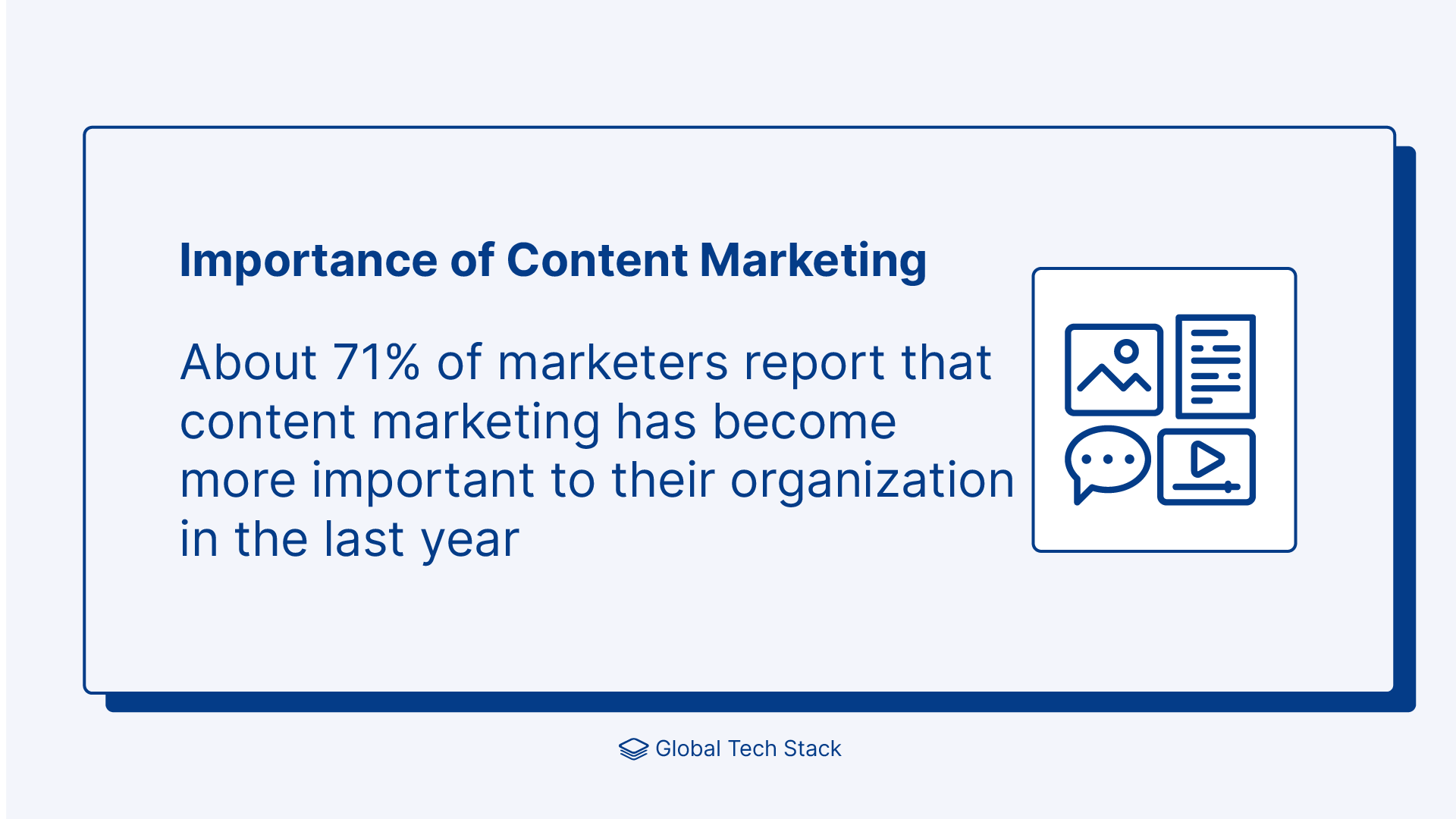
There is a significant shift in marketing priorities, with nearly three-quarters of marketers acknowledging that content marketing is on the rise within their organizations. This highlights the growing recognition of content’s pivotal role in contemporary marketing strategies.
2. Content Marketing is preferred for Lead Generation 76% of content marketers use content to generate leads (Parse.ly).
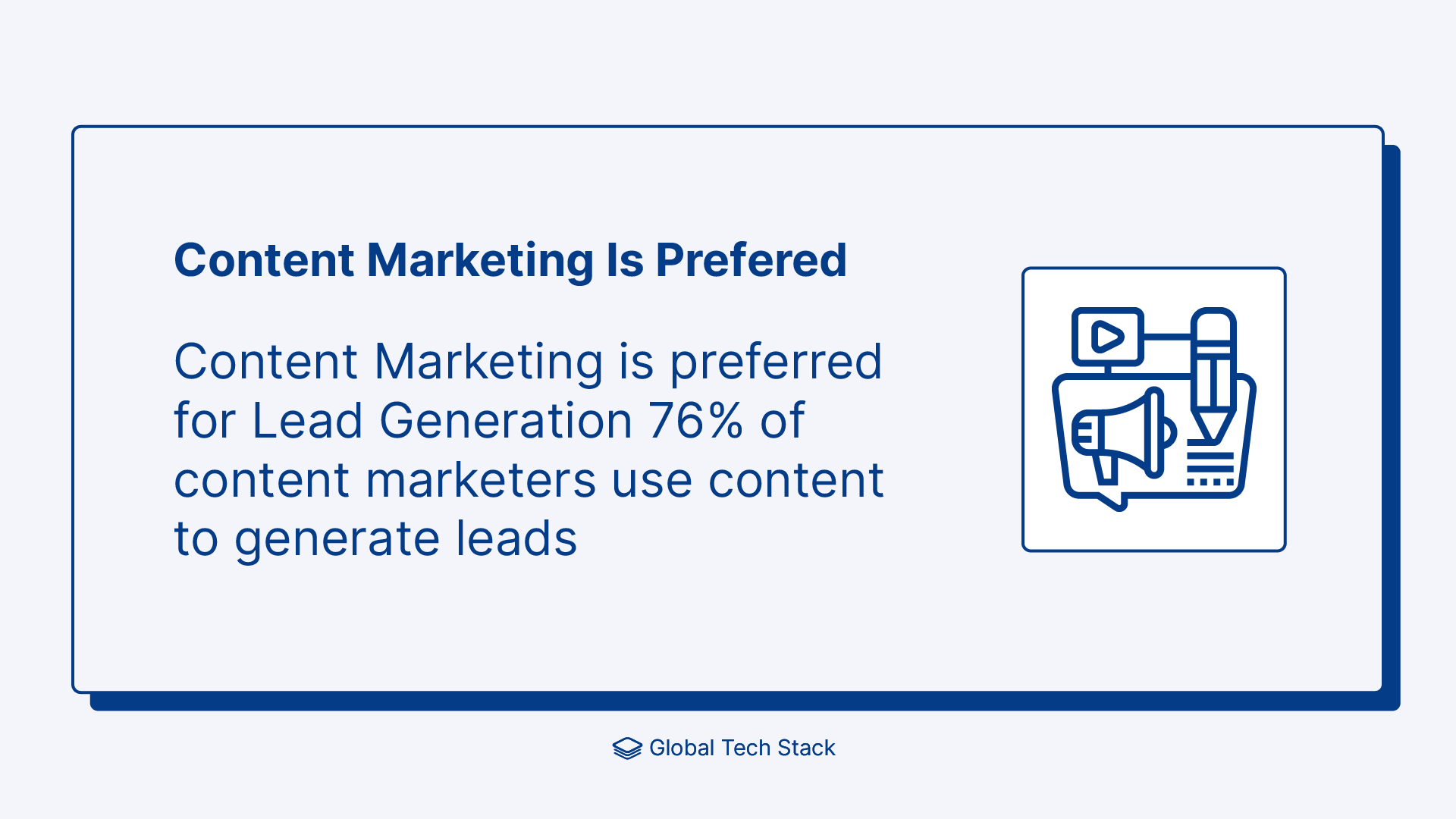
The primary objective of content marketing for a majority of practitioners is lead generation. That’s a substantial portion of content marketers leverage their content to attract and convert potential customers into leads.
3. The blogging landscape shows more than 600 million blogs out of 1.9 billion websites worldwide.
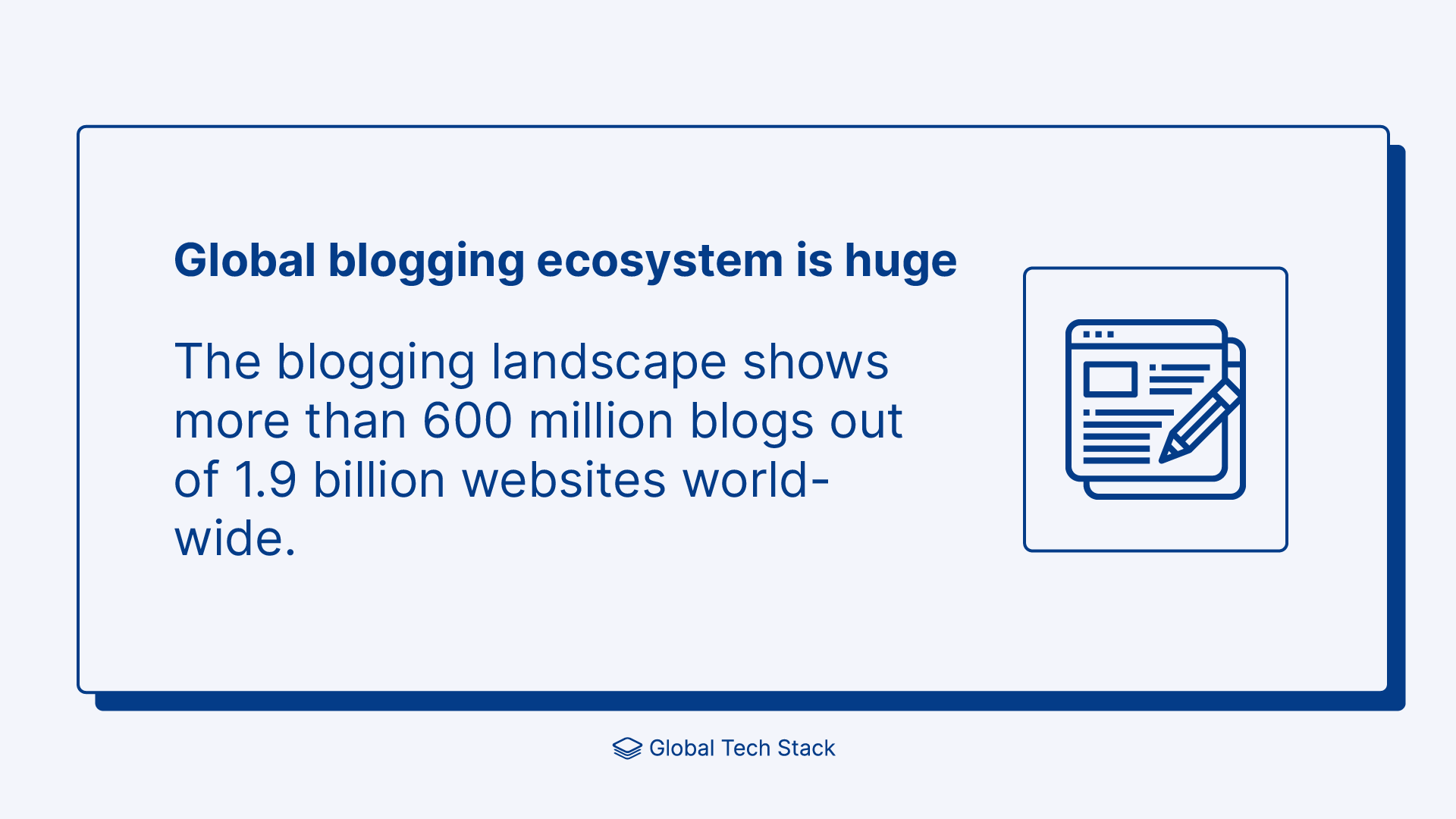
The global blogging ecosystem is a huge one. There is a sheer abundance of blogs amidst the vast digital landscape. This showcases the fierce competition bloggers face and the necessity for distinctive and high-quality content.
4. Blog reading habits seem to be positive. About 77% of internet users read blogs (Social Media Today), and nearly 26% of people in the U.K. aged 5–18 are reading blogs (Statista).
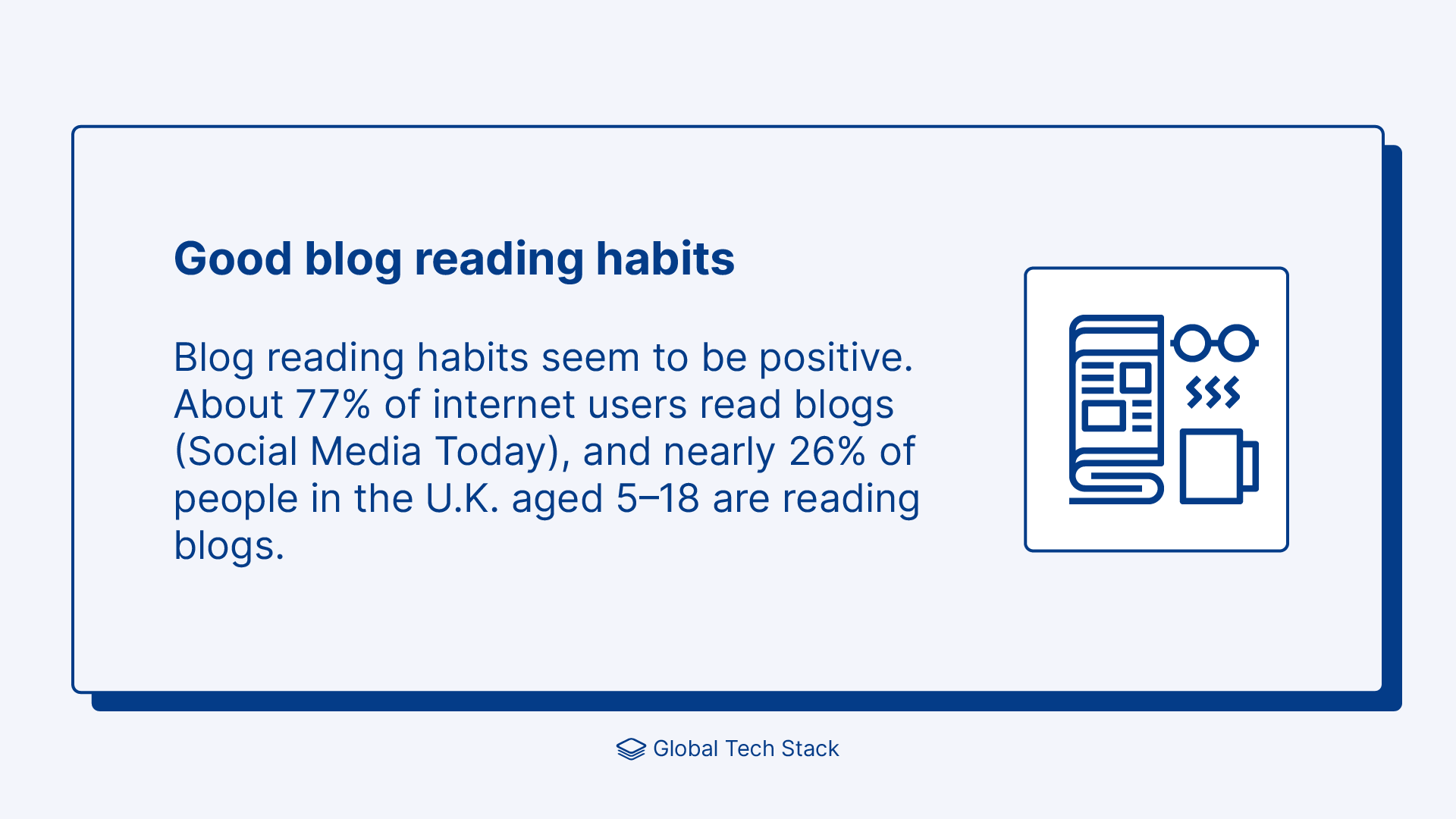
This is compelling evidence of the widespread readership of blogs, both globally and among specific demographics. There is therefore immense potential for reaching diverse audiences through this content format.
Social media blogging statistics show that a significant percentage of bloggers view social media as their primary source of traffic, highlighting its importance in driving traffic to blogs.
5. There is a strong positive correlation between word count and backlinks, but only up to 1,000 words. For posts longer than 1,000 words, there is a strong negative correlation between word count and backlinks (Ahrefs).
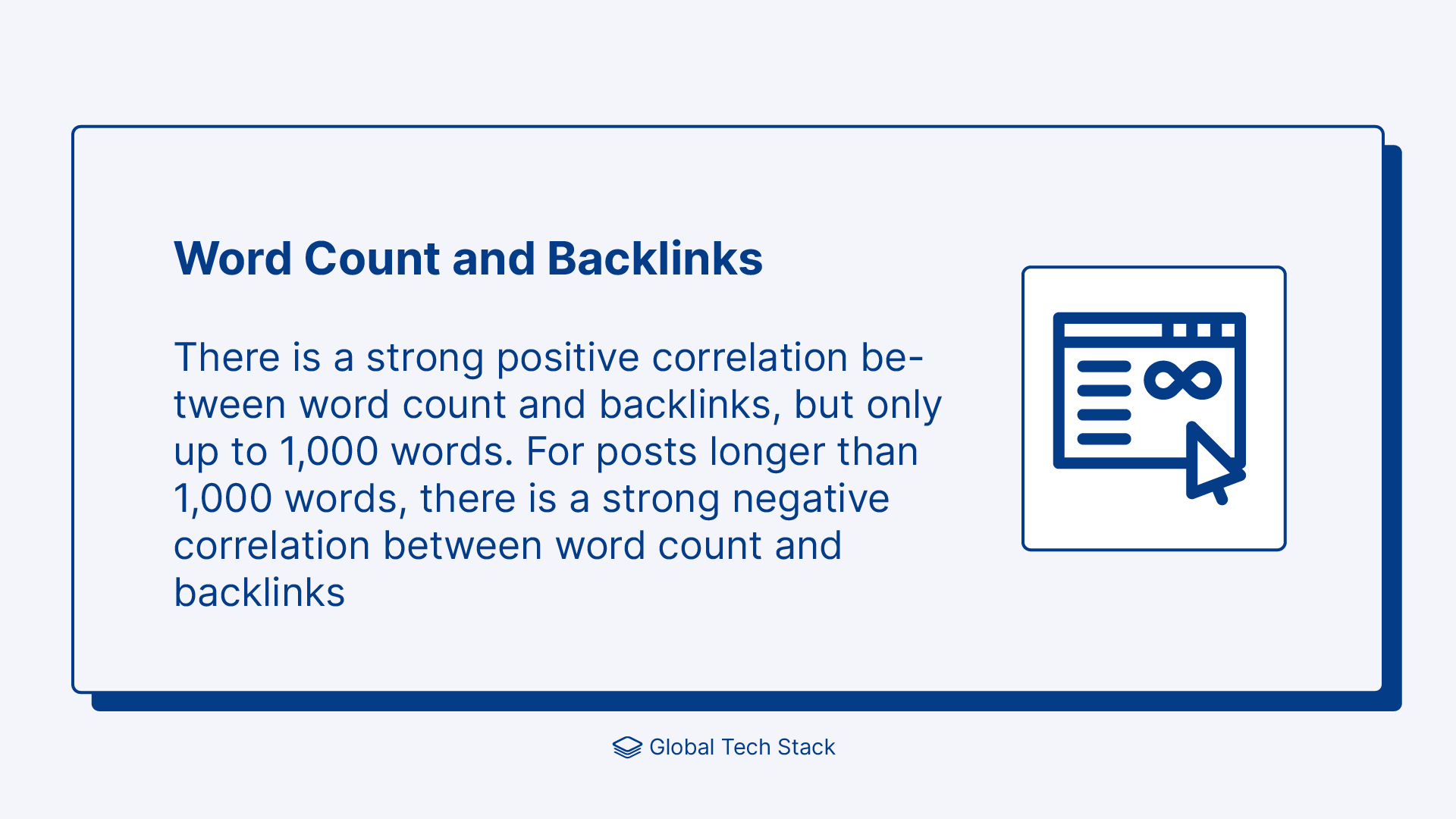
Word count and backlinks still have a significant correlation with a certain content length seems to be getting more backlinks. It suggests that there’s an optimal word count (around 1,000 words) where content tends to attract more backlinks. However, going beyond this limit may lead to diminishing returns in terms of backlink acquisition.
6. There is a moderate correlation between content length and organic traffic, but only up to 2,000 words. For posts longer than 2,000 words, there is a moderate negative correlation between word count and organic traffic (Ahrefs).
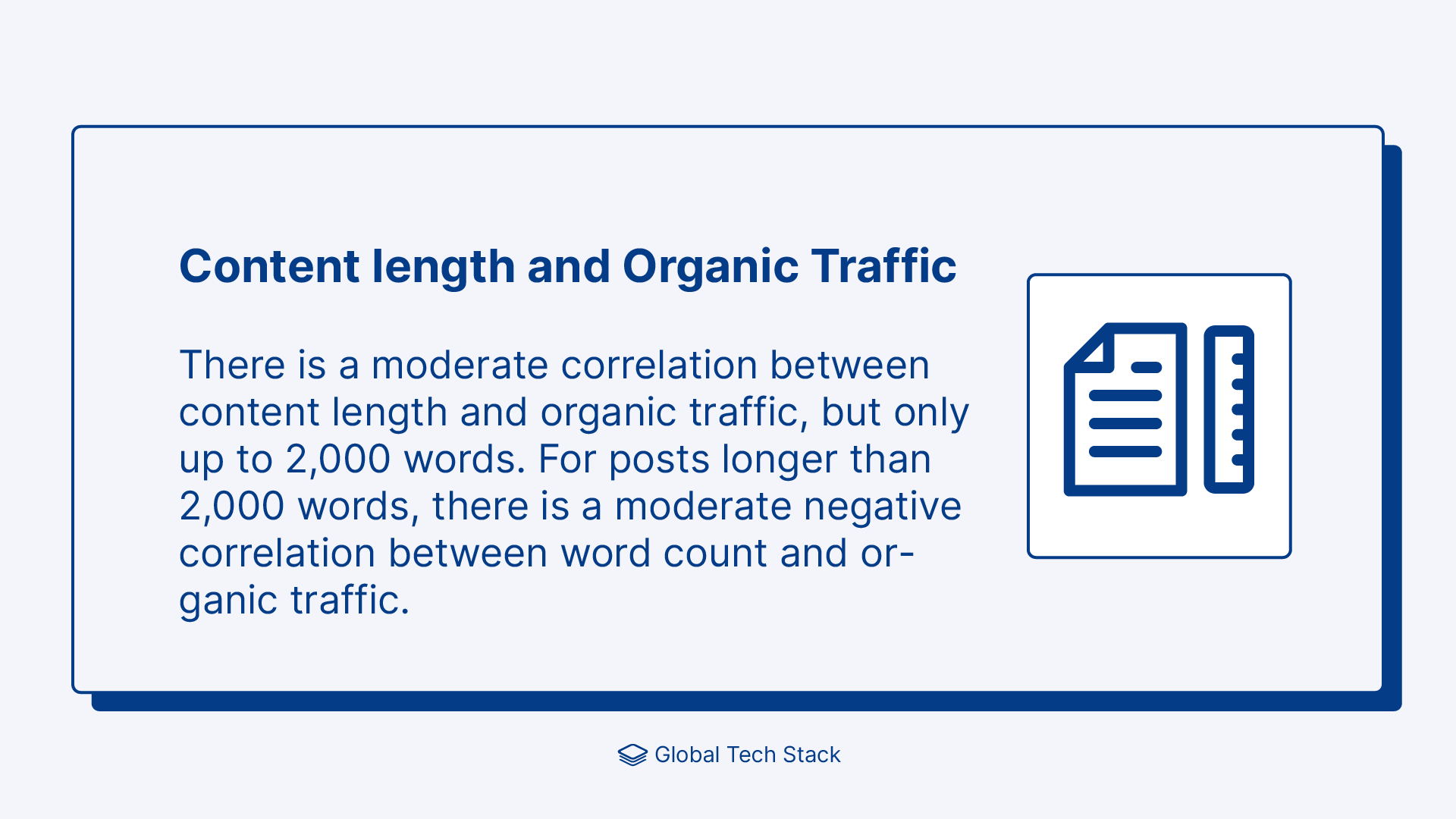
The relationship between content length and organic traffic can be seen with a big correlation for up to 2000 words. It indicates that while longer content can positively impact organic traffic up to a point (around 2,000 words), excessively long posts may see diminishing returns in terms of traffic generation.
7. Blogging drives results, about 80% of bloggers report that blogging drives results (Orbit Media).
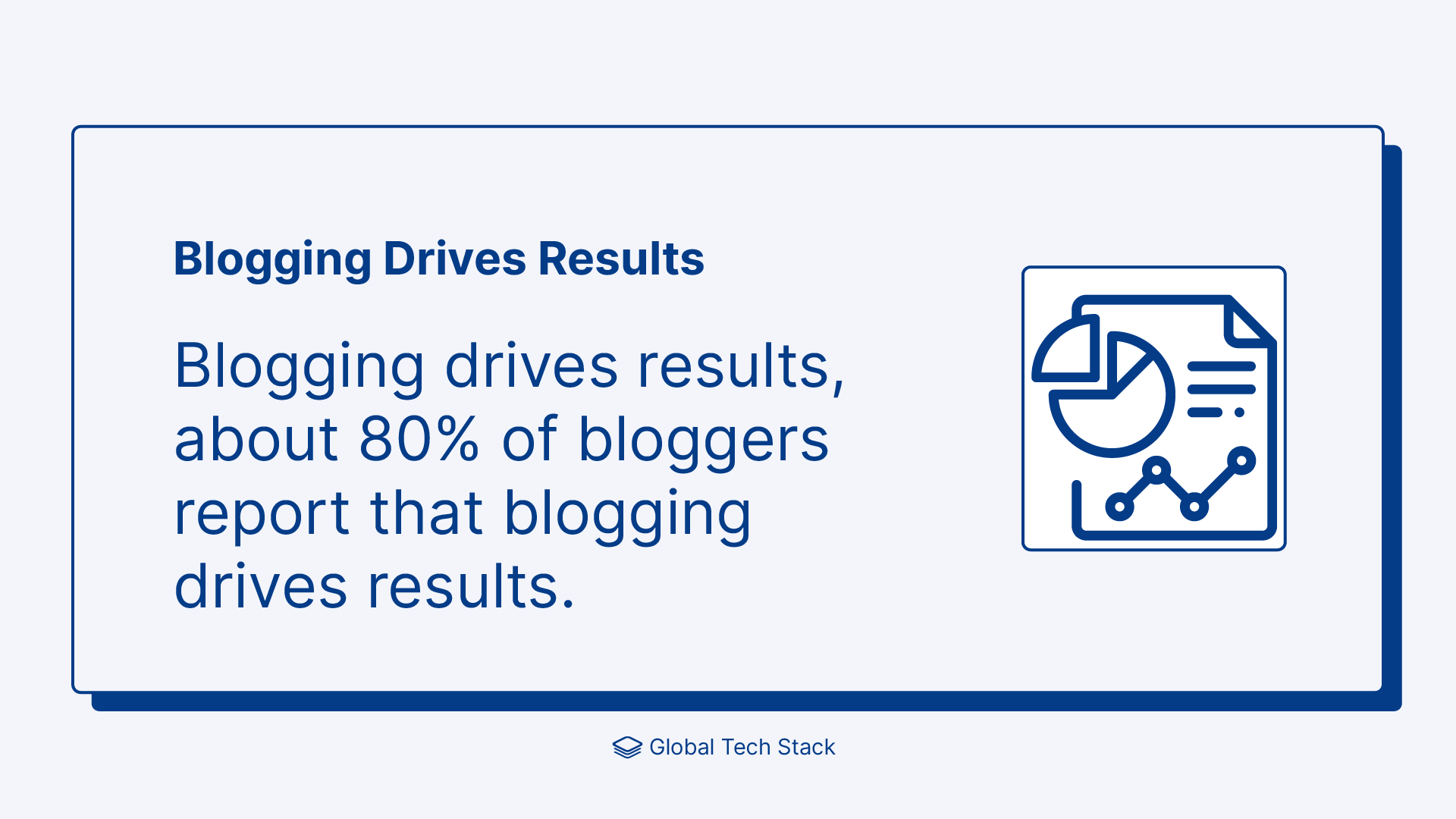
This resoundingly affirms the effectiveness of blogging as a marketing strategy. It underscores the fact that an overwhelming majority of bloggers experience tangible positive outcomes, reinforcing the value of consistent content creation.
8. Blogging Frequency for strong results. Bloggers who publish two to six times per week are 50% more likely to report strong results (Orbit Media).
This is to stress the importance of maintaining a regular blogging schedule. It highlights that bloggers who publish content at this frequency significantly increase their chances of achieving successful outcomes.
9. Bloggers who use 7+ images per post are 2.3X more likely to report strong results (Orbit Media).
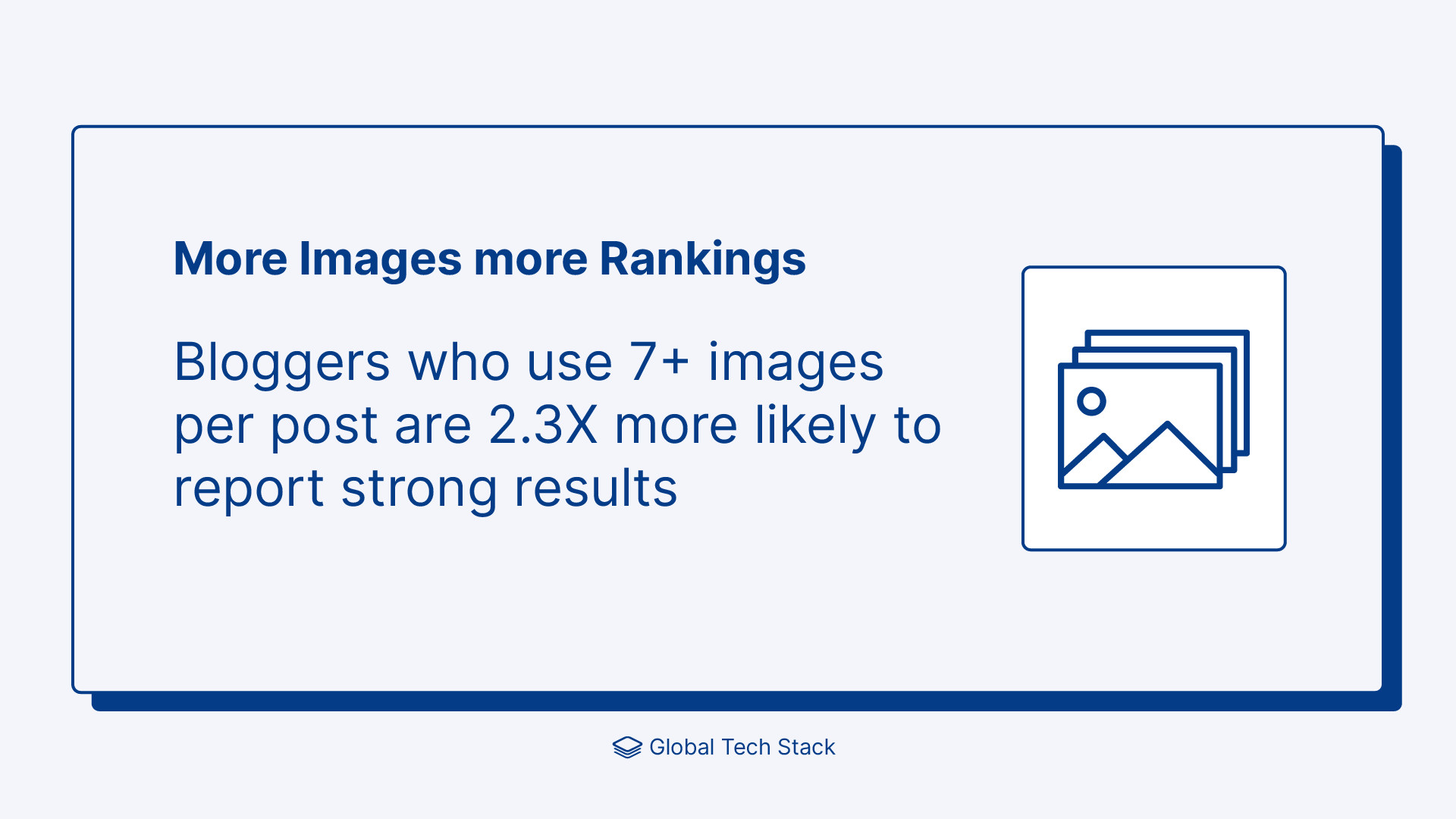
This is a spotlight on the role of visual content within blog posts. It underscores that incorporating a substantial number of images (seven or more) can substantially boost a blog’s performance and the likelihood of achieving favorable results.
10. Influential Content Types for B2B Buyers: 65% of B2B buyers cite vendor websites as one of their most highly influential content types.
10. Influential Content Types for B2B Buyersic: 65% of B2B buyers cite vendor websites as one of their most highly influential content types.
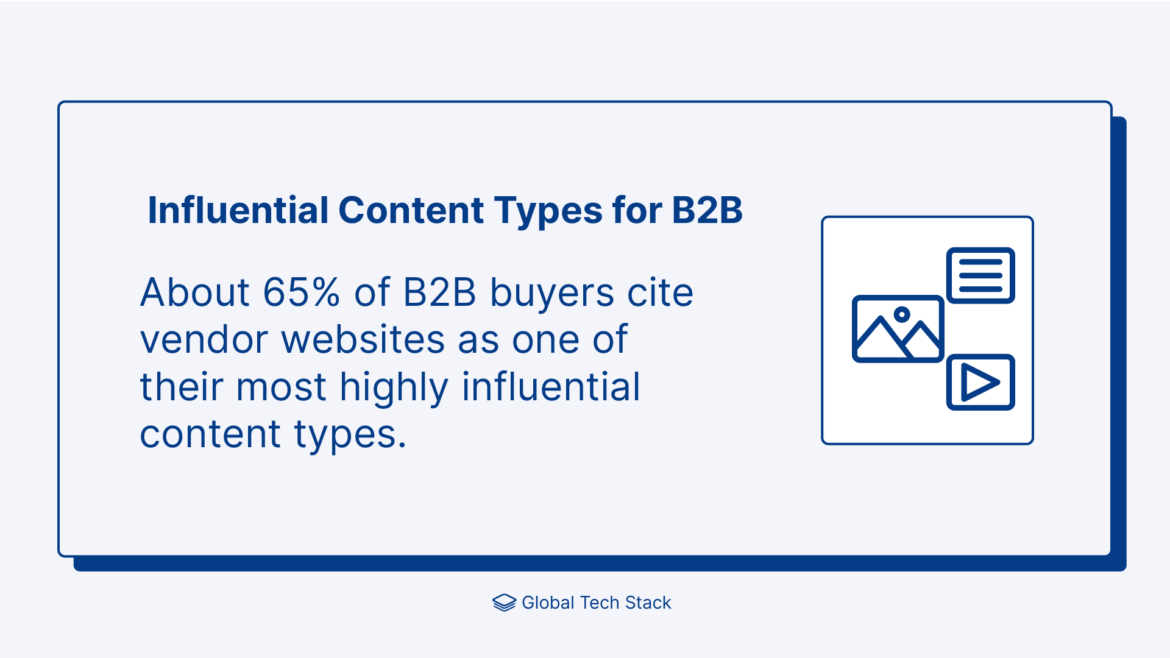
This is followed by third-party websites (48%) and third-party articles by independent publishers (39%) (MarketingCharts). This is a critical insight into the content preferences of B2B buyers. It showcases the paramount influence of vendor websites in the decision-making process, followed closely by third-party sources.
This is a surprising behavior on social media platforms – the sharing of links without actual content consumption. It underscores the challenge of capturing users’ attention through engaging headlines and visuals to encourage meaningful interactions with shared content.
Blogging SEO Statistics
12. Only 38% of bloggers are updating older articles.
A significant portion of bloggers may not be taking advantage of the potential SEO benefits of updating and refreshing their older content. This is a missed opportunity to improve search rankings and keep their content relevant.
13. According to a survey, 34% of bloggers have reported strong results after updating their content.
There is a positive impact of content updates on blog performance. A substantial portion of bloggers has experienced significant benefits, such as improved traffic and engagement, by regularly refreshing their existing content.
14. Around 5% of bloggers don’t have access to analytics.
This shows the importance of tracking and analyzing blog performance through analytics tools. Bloggers must have access to data to make informed decisions and optimize their content strategies.
15. Headlines containing 6 to 13 words tend to generate the most stable and substantial flow of traffic.
This statistic provides valuable insights into crafting effective blog post titles. It suggests that titles of moderate length (6-13 words) tend to perform the best in terms of attracting a consistent amount of traffic, emphasizing the importance of concise yet descriptive titles.
16. SEO leads have a close rate of 14.6%, whereas outbound leads, like direct mail or print advertising, only have a close rate of 1.7%.
The effectiveness of SEO-generated leads in the sales process. It demonstrates that leads generated through SEO efforts have a significantly higher likelihood of converting into customers compared to outbound leads.
17. According to a survey, 72% of online marketers stated that content creation is the most effective tactic for improving their website’s search engine optimization (SEO).
Content creation plays a crucial role in SEO strategies. It highlights that a significant majority of online marketers believe that producing quality content is the most effective approach for improving search engine rankings.
18. Companies that have active blogs get 97% more backlinks.
This highlights the significant relationship between having an active blog and acquiring more backlinks. It underscores the role of blogging in improving a website’s link profile, which can boost search engine rankings.
19. About 71% of bloggers agree that optimizing for search engines is the best way to get more traffic to your website.
This reflects the consensus among bloggers about the effectiveness of SEO in driving website traffic. It underscores the importance of optimizing blog content for search engines to increase visibility and attract visitors.
20. About 51% of companies measure the success of their blog content based on organic traffic, while 42% say that search ranking is the most important metric for measuring success.
This shows the key performance indicators (KPIs) that companies use to gauge the success of their blog content. It emphasizes the central role of organic traffic and search rankings as primary metrics for evaluating blog performance.
21. About 27% of bloggers always research keywords, but 15% of bloggers admit they never do keyword research.
The varying approaches to keyword research among bloggers. While a significant percentage always conduct keyword research, a noteworthy portion neglects this crucial step. Keyword research however saves bloggers from heating empty targets. It sets the right path for blogging efforts that bring results.
22. When we look at the bloggers who always research keywords, 37% say they get “strong results” from their posts. This is a big contrast to the bloggers who never research keywords, as just 11% of those writers get strong results.
The impact of keyword research on the effectiveness of blog posts is huge. Bloggers who consistently research keywords tend to achieve stronger results, highlighting the value of understanding audience search intent. Also being able to identify what you can rank quickly for.
23. About 29% of bloggers always check their Google Analytics. It is concerning to note that 4% of respondents reported that they do not have access to Google Analytics.
There are varying levels of Google Analytics usage among bloggers. While a significant percentage always monitors their website’s analytics, a small but concerning proportion lacks access to this essential tool.
24. About 36% of bloggers who regularly check their Google Analytics report “strong results” from their posts.
This emphasizes the correlation between regularly monitoring Google Analytics and achieving strong results in blogging. It underscores the importance of data-driven decision-making and performance analysis.
25. Unsurprisingly, just 10% of bloggers who never or rarely check their Google Analytics get “strong results.”
There is a negative impact of infrequent or non-existent Google Analytics monitoring on blogging outcomes. It reaffirms the importance of analytics in optimizing blog content and strategy for better results.
Blogging Revenue and Monetization
Blogging can be a lucrative endeavor, with many bloggers generating significant income from their efforts. Approximately 21% of bloggers earn between $100-$1,000 per month, while the average blogger earns around $100-$300 per month. However, 45% of bloggers earn less than $100 per month, indicating a wide range of income levels within the industry.
Advertising remains a popular monetization strategy, with 45% of bloggers using ads to generate revenue. Affiliate marketing is another common approach, employed by 35% of bloggers to earn commissions by promoting products and services. Sponsored content is also a viable option, with 25% of bloggers partnering with brands to create paid posts.
Email marketing is utilized by 20% of bloggers to monetize their audience, often through newsletters and exclusive content. Additionally, product sales and services are revenue streams for 15% and 10% of bloggers, respectively. These diverse monetization strategies highlight the various ways bloggers can turn their passion into profit.
Blogging Challenges and Solutions
Blogging is not without its challenges. Creating high-quality content is a significant hurdle, with 62% of bloggers struggling to produce engaging and valuable posts consistently. To overcome this, bloggers can focus on thorough research, understanding their audience, and leveraging tools to enhance content quality.
Promoting a blog is another common challenge, faced by 55% of bloggers. Effective promotion requires a multi-faceted approach, including SEO, social media marketing, and networking with other bloggers. Monetizing a blog is also difficult, with 45% of bloggers finding it challenging to generate revenue. Diversifying income streams and experimenting with different monetization strategies can help address this issue.
Time management is a critical concern, with 35% of bloggers struggling to balance blogging with other responsibilities. Creating a content calendar and setting realistic goals can aid in managing time effectively. Staying up-to-date with industry trends is essential, yet 25% of bloggers find it challenging. Regularly reading industry news, attending webinars, and participating in online communities can help bloggers stay informed.
Building an audience is another challenge, with 20% of bloggers struggling to attract and retain readers. Engaging with the audience through comments, social media, and email newsletters can foster a loyal readership. Lastly, creating a content calendar is a challenge for 15% of bloggers. Planning content in advance and using scheduling tools can streamline the blogging process and ensure consistency.
The Future of Blogging
The future of blogging is poised to be shaped by technological advancements and changing reader behaviors. Artificial intelligence is already making its mark, with 80% of bloggers using AI tools for tasks such as content creation, SEO optimization, and audience analysis. This trend is expected to grow, making AI an integral part of the blogging landscape.
Video content is gaining popularity, with 25% of bloggers incorporating videos into their posts. This trend is likely to continue, as videos can enhance engagement and provide a richer user experience. Influencer marketing is also on the rise, with 50% of bloggers collaborating with influencers to expand their reach and credibility.
Podcasting is another emerging trend, with 15% of bloggers using this medium to connect with their audience. Virtual events are becoming more common, with 10% of bloggers hosting webinars, live streams, and online workshops. Augmented reality, though still in its infancy, is being explored by 5% of bloggers to create immersive and interactive content.
As technology evolves, so do the preferences and behaviors of blog readers. Bloggers must stay adaptable and embrace new tools and trends to remain relevant. The future of blogging will be defined by innovation, creativity, and the ability to connect with audiences in meaningful ways.
Get the best out of Your Digital Channels
These latest and most important blogging statistics are essential for any blogger to be aware of. Understanding these insights can help inform decisions on topics such as content length, frequency, types of visuals used, and the influence of different sources on potential customers.
Blogging is an integral part of any digital marketing strategy, as it can help drive customer acquisition, increase brand visibility, and cultivate loyal followers. With ubiquitous internet access comes increased opportunities for bloggers around the world to benefit from new technologies that can potentially boost their efforts in content creation and dissemination.
Frequently Asked Questions (FAQ) About Blogging Statistics
1. What is the average blog post length in 2024?
The average blog post length in 2024 is approximately 1,416 words. However, optimal blog post lengths can vary depending on the purpose of the content and the audience’s preferences.
2. How often should bloggers publish new content?
Bloggers typically publish new content between three to six times per month. Consistency in publishing is key to building a loyal audience and achieving successful outcomes.
3. Is blogging still profitable in 2024?
Yes, blogging remains profitable in 2024. Many bloggers generate significant income through various monetization strategies, such as advertising, affiliate marketing, and sponsored content.
4. What percentage of internet users read blogs?
About 77% of internet users regularly read blogs, indicating a strong readership and potential reach for bloggers.
5. How important is SEO for blogging?
SEO is crucial for blogging as it significantly impacts visibility and traffic. Bloggers who optimize their content for search engines are more likely to attract visitors and achieve better search rankings.
6. What are some common challenges bloggers face?
Common challenges include creating high-quality content, promoting the blog, monetizing the blog, managing time effectively, and building an audience.
7. How can bloggers improve their content marketing strategy?
Bloggers can improve their content marketing strategy by researching relevant keywords, updating older content, using analytics to track performance, and engaging with their audience through various channels.

